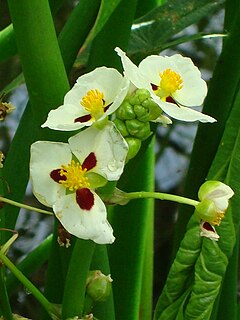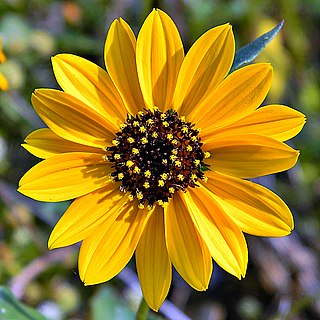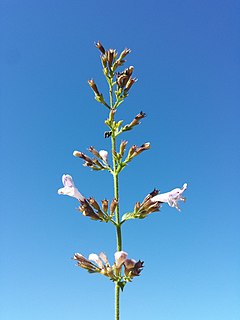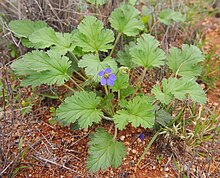
Pinus contorta, with the common names lodgepole pine and shore pine, and also known as twisted pine, and contorta pine, is a common tree in western North America. It is common near the ocean shore and in dry montane forests to the subalpine, but is rare in lowland rain forests. Like all pines, it is an evergreen conifer.

Catharanthus is a genus of flowering plants in the family Apocynaceae. Like the genus Vinca, they are known commonly as periwinkles. There are eight known species. Seven are endemic to Madagascar, though one, C. roseus, is widely naturalized around the world. The eighth species, C. pusillus, is native to India and Sri Lanka. The name Catharanthus comes from the Greek for "pure flower".

Eutaxia is a genus of the family Fabaceae. They are native to Australia. Most are endemic to the Southwest Botanical Province of Western Australia, but a few are distributed throughout mainland Australia. The chromosome number of Eutaxia species is typically 2n = 14 or 16.

Physocarpus, commonly called ninebark, is a genus of flowering plants in the family Rosaceae, native to North America and northeastern Asia.

Anthemis arvensis, also known as corn chamomile, mayweed, scentless chamomile, or field chamomile is a species of flowering plant in the genus Anthemis, in the aster family. It is used as an ornamental plant.

Mirbelia is a plant genus belonging to the family Fabaceae. It is endemic to Australia, occurring in every mainland state except South Australia.

Goodia is a genus in the pea family, Fabaceae.

Pulsatilla patens is a species of flowering plant in the family Ranunculaceae, native to Europe, Russia, Mongolia, and China. Common names include Eastern pasqueflower and cutleaf anemone.

Sagittaria montevidensis is a species of flowering plant in the water-plantain family Alismataceae. Common names include giant arrowhead and California arrowhead.

Daucus glochidiatus, commonly known as Australian carrot, Austral carrot or native carrot, is a species of herb in the flowering plant family Apiaceae. It is native to Australia and New Zealand.

Barklya is a genus of Australian trees in the legume family, Fabaceae. It belongs to the subfamily Caesalpinioideae. The sole species is Barklya syringifolia, commonly known as the leather jacket or crown of gold tree. It grows in rainforest to 18 metres tall. Recorded from Queensland and New South Wales in vine forest and softwood scrub. It is often used as an ornamental. It may be extinct in New South Wales.

Acer pictum subsp. mono, commonly known as painted maple or mono maple in English, itayakaede (板屋楓) or ezoitaya (蝦夷板屋) in Japan, 五角枫 in China, or gorosoe (고로쇠) or gorosoenamul (고로쇠나무) in Korea, is a species of maple.

Verbascum virgatum, commonly known as twiggy mullein and wand mullein, is a plant species in the family Scrophulariaceae.

Rhododendron minus var. minus, the Carolina azalea or Carolina rhododendron, is a rhododendron species native to the mountains of North Carolina, South Carolina, Tennessee, and Northeast Georgia. It is commonly known as Rhododendron carolinianum in the horticultural trade.

Pavonia hastata, commonly known as spearleaf swampmallow or pink pavonia, is a shrub in the family Malvaceae. The species is native to Brazil, Bolivia, Argentina, Paraguay and Uruguay. It was previously considered to be native to Australia as well, but is no longer thought to be.

Helianthus debilis is a species of sunflower known by the common names cucumberleaf sunflower, beach sunflower, weak sunflower, and East Coast dune sunflower. It is native to the United States, where it can be found along the Atlantic and Gulf Coasts. It is known elsewhere as an introduced species, such as South Africa, Australia, Taiwan, Slovakia, and Cuba.

Bothriochloa macra, commonly known as red-leg grass, red grass, redleg or pitted beard grass is a perennial grass species that is native to eastern Australia and New Zealand. It is naturalised in Tasmania and Norfolk Island.
Ranunculus anemoneus, commonly known as the anemone buttercup, is an endangered species of buttercup found in alpine Australia.

Clinopodium menthifolium, commonly known as the wood calamint or woodland calamint, is a species of flowering plant in the mint family, Lamiaceae. It is found throughout southern and central Europe from the United Kingdom and east as far as temperate parts of Asia, and as south as North Africa. It grows up to 1,700 m (5,600 ft) in elevation.


















